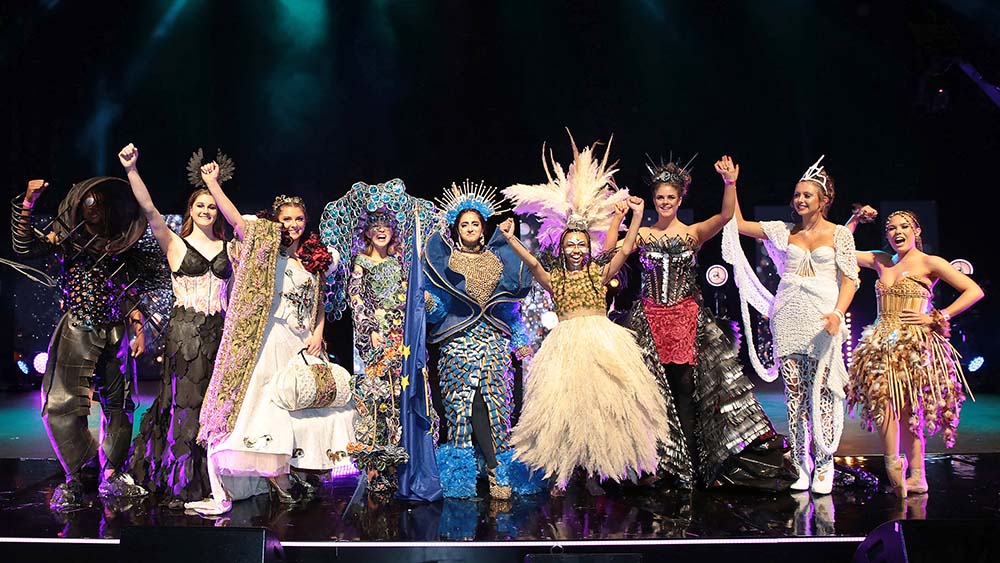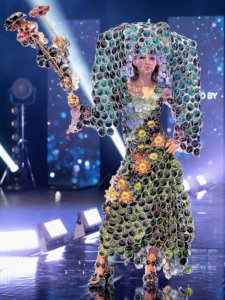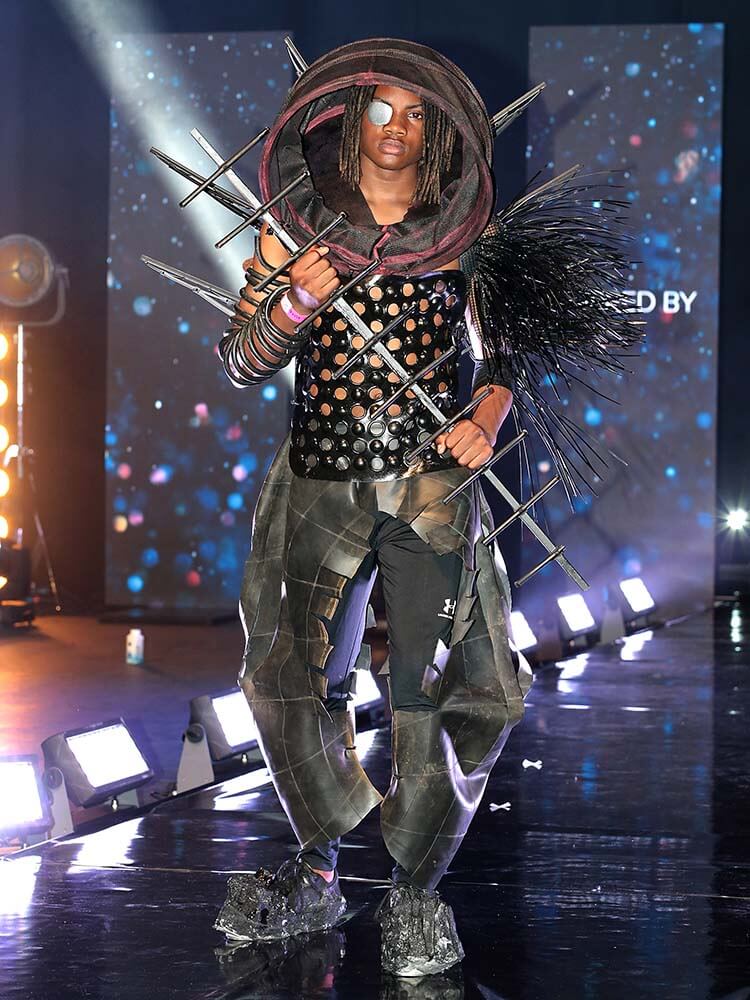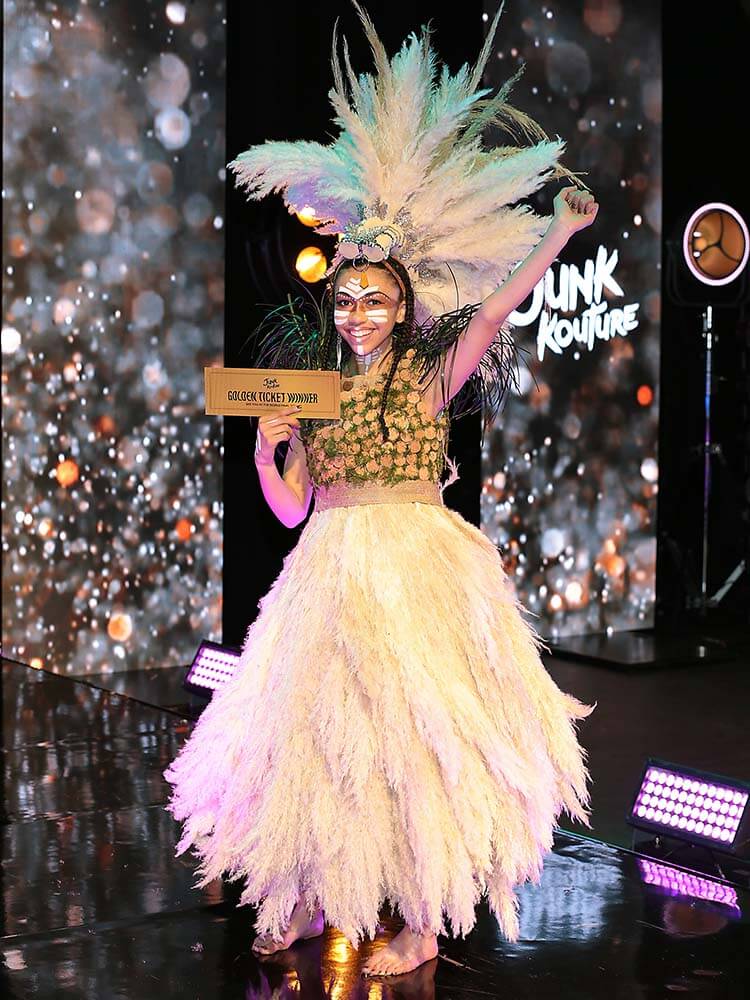
Once Junk Kouture — a competition for students to create wearable fashion made from recycled materials — went on tour, team members realized they needed to create a world final, “an Olympics of creativity.”
Troy Armour is CEO of Northern Ireland-based entertainment, media, and tech company Patral Group, as well as CEO of the consultancy Trojan Technologies. Oh, and he also has a side hustle: Since 2010, he has been the founder and CEO of Junk Kouture, a global competition that challenges students aged 13-18 to create high-end wearable fashion made from 100-percent recycled materials — everyday junk — that would otherwise have ended up in landfills.
It’s easy enough to trace the start-up’s origins — he came across a dance teacher who was creating fashion out of trash and running small shows in Northern Ireland. “I saw there was something more in it and that it could be so much bigger,” Armour told Convene via Zoom from his home in Londonderry. The two worked together for five years until Armour took the project over on his own.

Troy Armour
But getting at why Junk Kouture became such a passion project for Armour took some doing — and required a box of tissues in a lecture hall at MIT in Cambridge, Massachusetts — to coax out. As he tells the story, 2018 was his “annus horribilis, disaster of a year,” when he had the realization that Junk Kouture was stalling because of his own inability to expand the concept to teens beyond Ireland. Never thinking that he would be accepted, Armour, who is a member of Entrepreneurs’ Organization, applied for a master’s in leadership and entrepreneurship at MIT, an annual program the nonprofit runs for a cohort of 60 participants. He made the cut.
At a night lecture, the facilitator brought out a box of tissues and said, “We’re going to need this tonight because you’re all going to cry.” Armour couldn’t figure out what he meant by that. When it was his turn to share, the facilitator said to him, “‘So, why this Junk Kouture thing?’” Armour gave a stock answer — he just loved creativity and fashion. But the facilitator kept at him. “Every answer I gave, he just said, ‘But why?’” he recalled.
“After eight or nine times, you’re in a corner. Your cohorts are looking at you and you’re starting to cry. And I remember saying, ‘Because every one of those kids was me. They’re me.’
“I’d never told anybody that before, but that’s the realization that happened.”
The Creative Kid
Growing up in rural Northern Ireland with very little money, Armour said his creative outlet was to make art out of “rubbish” — like painting empty cornflakes boxes or sewing a karate suit for his brother using his mother’s old dusters. But the downside to being a creative kid, he said, is you rarely fit in. “School wants you to be academic. And then in the yard, it was all about sports. And, of course, I was that kid last picked for every sports team. You’re going through rejection by your peers every single day,” Armour said. “What people don’t realize is that there’s so much social capital got through sport.”
After his breakthrough moment at MIT, he began thinking of Junk Kouture as “the sport for creative kids. Why do they have to play soccer or American football or rugby? They’re cool at doing this stuff,” Armour said. “And they can compete with their peers because sport, at the end of day, is where two or more people compete using skill or talent.”
- Claim or renew your subscription to Convene.
- Want deep-dive insights on events delivered to your inbox? Sign up for our newsletters.

The competition is material-agnostic — participants (here and below) need to prove where they got the materials for their outfits and that they weren’t purchased for this use.
He challenged his team: “There are creative kids in every classroom in the world and they don’t have this. Wouldn’t it be cool if they did? How do we build this as a global thing?” They turned to the Formula 1 model, where participants race in cars that they built, translating that to “building outfits” and then “rocking them down a catwalk. And then what does Formula 1 look like? It’s a big event every two or three weeks,” he said. “That was the genesis of Junk Kouture as we know it now.”
The COVID shutdown gave his team a break from hosting events to approach sponsors, do a seed investment round to raise funds, and polish a 21-week masterclass program for teachers and students on designing Junk Kouture outfits.
The competition now takes place in six cities each year, with an additional four cities planned to be added within the next two years, with the goal of touring in 13 cities across six continents. And on Jan. 11, 2023, those competitions will culminate in the inaugural Junk Kouture World Final at the Etihad Arena in Abu Dhabi, where 60 designers and their teams from secondary schools across the globe will compete for awards, including the Junk Kouture World Designer of the Year.
It will be “the Eurovision of fashion — a celebration of creativity and color and diversity and no privilege and sustainability,” Armour said. “And for those kids involved — whether they’re from Sao Paulo, Mumbai, New York, or Sydney — it will be free to enter. Their transportation to world finals and all will be free.”
The fashion competitions give participating teens a sense of confidence, by getting on stage and showing off their work to an audience, Armour said. “When you compete, people start to recognize your skills being celebrated and all of a sudden, you’ve become somebody. You were always that person, but it’s the recognition. It’s so important.”



Superseding Sustainability
Sustainability, Junk Kouture’s Troy Armour said, isn’t the No. 1 aspect of the program that potential sponsors respond to when pitched on the concept. “We think it will be when we approach them,” he said. “But it’s more about young people being celebrated, the diversity and inclusivity of it. Sustainability is obviously a driver in there, but more of the questions we get are around education — experiential education, not rote learning.”
In terms of his efforts to make Junk Kouture’s competitions more environmentally responsible, Armour said they encourage audience members to come via public transport, plastic water bottles are banned, and they vet the venues — host venues use renewable energy.
“It’s a mindset. Some of the things you can do, some of the things you can’t,” Armour said. “There’s not a solution for everything at the moment, but we’ve moved away from things that create waste, that have other repercussions.”
As far as what becomes of the Junk Kouture outfits themselves, some of them are made out of organic materials that get planted, Armour said, and some stay on display as “museum pieces” at the schools that offer the program. The afterlife of their creations is something student participants are required to be intentional about — it’s part of the competition criteria.
Armour said Junk Kouture’s impact “stretches far beyond just the kids that take part and the empowerment they get.” What they learn over the course of the nine-month program is how to become “circular engineers,” he said, because they say to themselves, “Well, if I turned Coca-Cola cans into this, then can I reuse other things” — that whatever comes in the door is reused in some way, and not going back out in the trash. “Because going back out,” he said, “just means you’re passing the problem to somebody else to solve for you.”
Michelle Russell is editor in chief of Convene.
